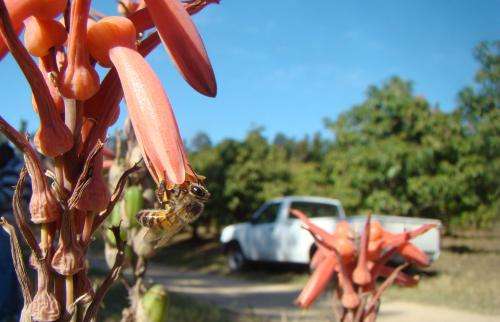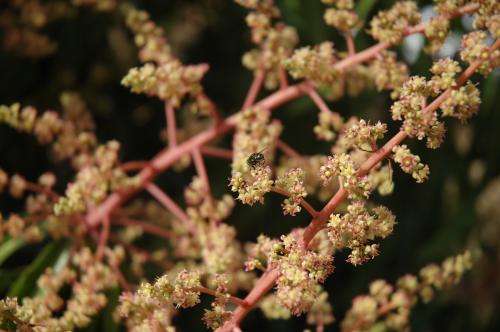Small patches of native plants help boost pollination services in large farms

A combined team of scientists from Europe and South Africa (Luísa G. Carvalheiro (University of Leeds, UK & Naturalis Biodiversity Research Centre, Netherlands), Colleen Seymour and Ruan Veldtman (SANBI, South Africa) and Sue Nicolson (University of Pretoria)) have discovered that pollinator services of large agriculture fields can be enhanced with a simple cost-effective measure, that involves the creation of small patches of native plants within fruit orchards.
"Mango farmers in South Africa are aware of the pollination limitation of this crop and invest a substantial amount of money renting honeybee hives to supplement pollination within the large farmland areas. However, while during blooming season, mango fields can have millions of open flowers, those flowers are not very attractive to neither local wild pollinators nor managed honeybees." says the lead author Luísa Carvalheiro.
While pesticide use and isolation from natural habitat lead to declines in flying visitors and in mango production (kg of marketable fresh fruit), the results of this study show that the presence of small patches of native flowers within large farms can ameliorate such negative impacts, increasing the number of visits of honeybee and wild pollinators to mango, and consequently mango production. As these patches do not compromise production areas and its maintenance has very low costs, such native flower compensation areas represent a profitable management measure for farmers, increasing cost-effectiveness of cropland. Further studies are needed to determine the optimum size and flower composition of such flower areas that maximizes benefits.

However, the effectiveness of flower patches is likely dependent on the preservation of remaining patches of natural habitat and judicious use of pesticides. The study was published in Journal of Applied Ecology, fieldwork was funded by SANBI – South African National Biodiversity Institute and data analyses by the project STEP – 'Status and Trends of European Pollinators' that is funded by the European Union Framework Program 7.
More information: Luisa G. Carvalheiro, Colleen Seymour, Sue W. Nicolson and Ruan Veldtman. 2012. Creating patches of native flowers facilitates crop pollination in large agricultural fields: mango as a case study – Journal of Applied Ecology, vol. 49, no 6, 1374-1384. doi: 10.1111/j.1365-2664.2012.02217.x
Journal information: Journal of Applied Ecology
Provided by Pensoft Publishers













.jpg)







